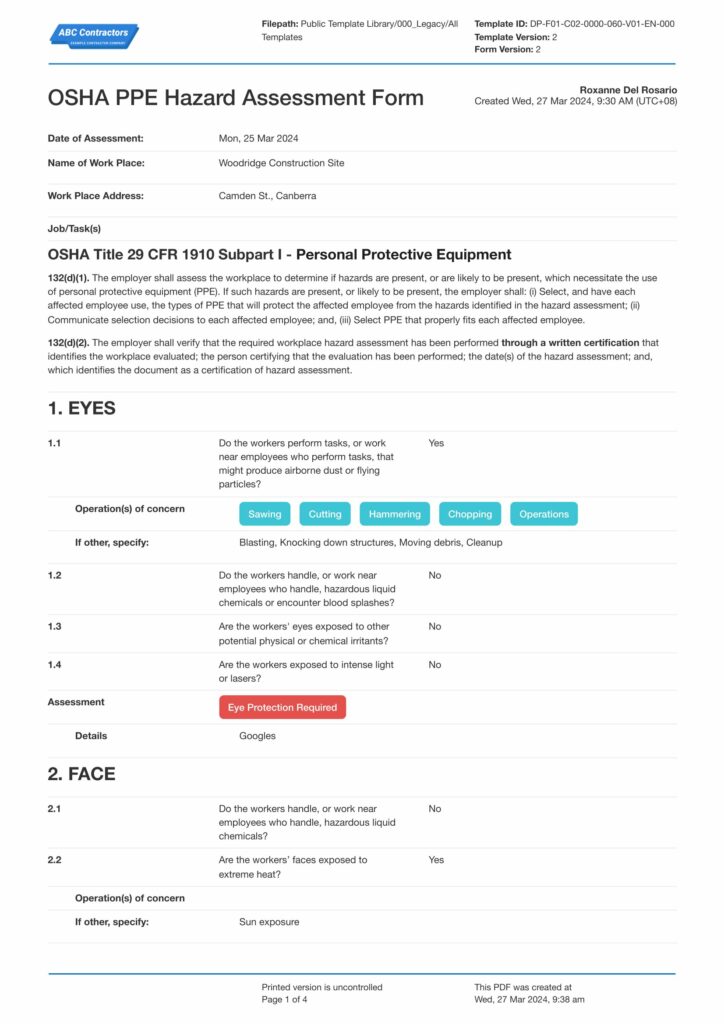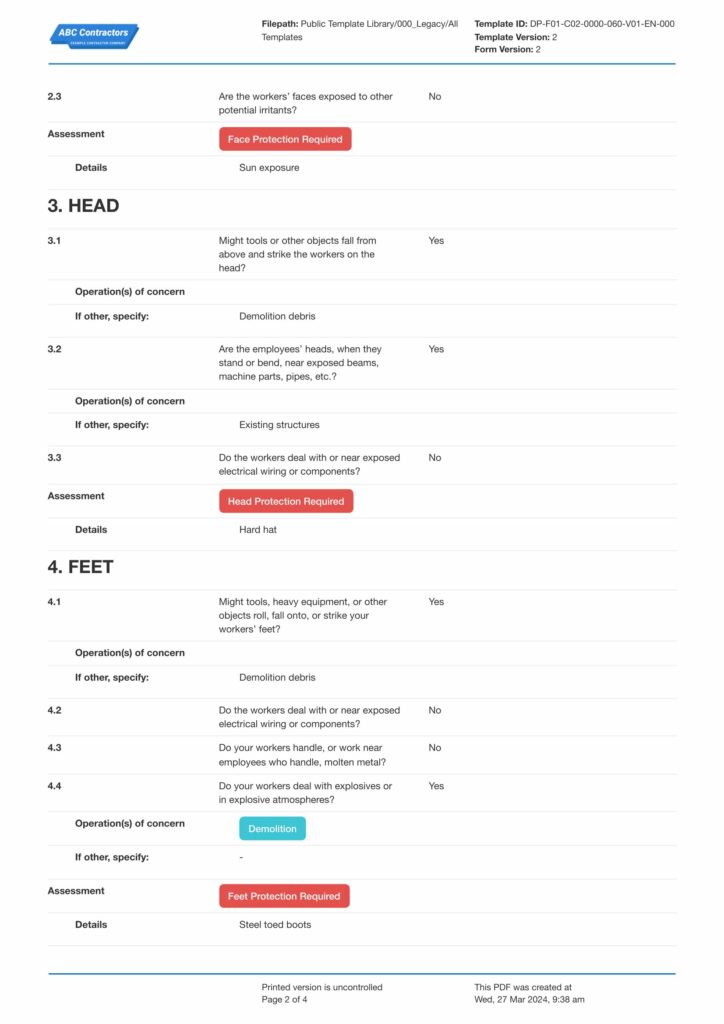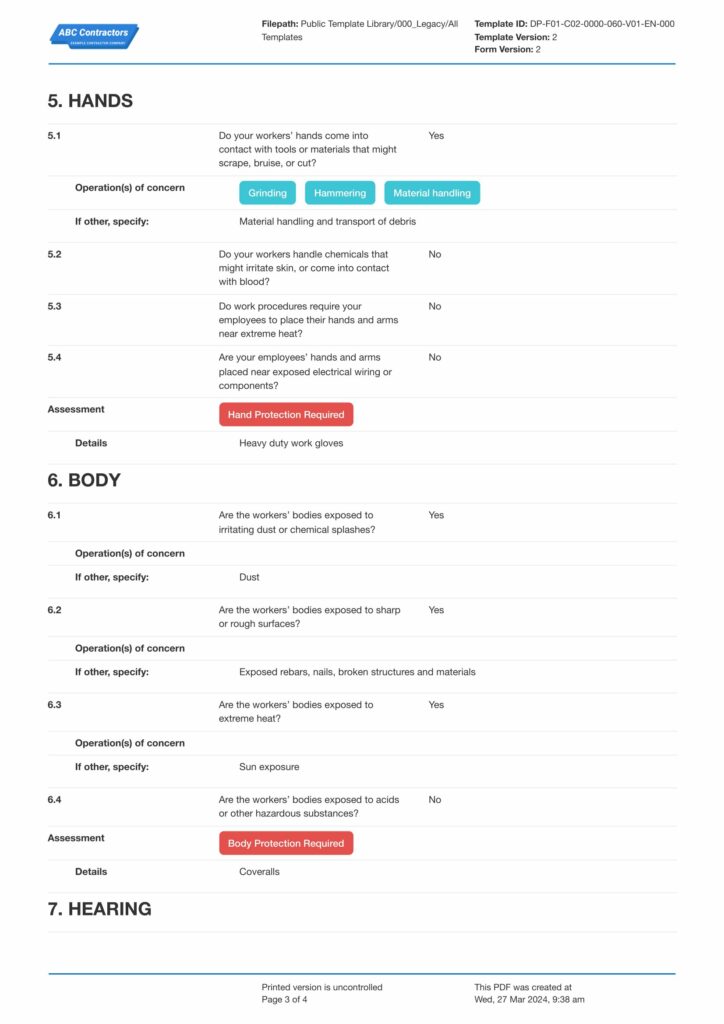Dashpivot Article – PPE Hazard Assessment Example
Table of Contents
Article Summary
- A PPE hazard assessment ensures that employees have all the right personal protection for the right circumstance in every hazard found in their daily operational activity.
- To conduct a proper PPE hazard assessment, the following procedures must be followed: review hazards in procedures, check for hazards in the surroundings, evaluate the risk, select the correct PPE, implement and record, and have constant reassessments.
- Conducting a PPE hazard assessment is not a one-time thing but a frequent process that must be done before every activity, changes in work procedures, changes in the environment, and after every incident.
Why is a PPE Hazard Assessment important?
The personal protection equipment (PPE) that workers are required to wear on the job serves a similar purpose as an umbrella. While an umbrella doesn't stop the rain, it does protect you from getting wet. Likewise, PPE doesn't eliminate hazards, but it does protect workers by reducing their effects.
However, the effectiveness of PPE relies on its appropriate selection for the specific hazard in a given situation or activity. Choosing the wrong PPE for a given hazard would be like bringing a knife to a gunfight.
Wearing the incorrect personal protective equipment (PPE) provides little to no safety. For this reason, companies and workplaces should do a PPE hazard assessment. The PPE hazard assessment examines the pertinent risks of the task, the environment, and the work practices; the appropriate personal protective equipment may then be chosen based on the findings. This method always ensures the correct PPE for the appropriate circumstances, guaranteeing a safe activity.
How to format your PPE Hazard Assessment to have full protection against hazards?
Employees are effectively protected when they have all the tools necessary to defend themselves from any risks that may be present. The most effective way to do this is to conduct a PPE hazard assessment. Furthermore, to guarantee that the workers are properly outfitted with the appropriate personal protective equipment (PPEs), the evaluation must first identify and analyze the environmental and activity hazards as well as their potential effects on human health.
With that said, the PPE hazard assessment forms must guide workers in identifying the hazards and help them determine which body part is exposed to such. Having this kind of approach would ensure that the worker has full coverage of protection from the hazards when executing the activity. To better understand the formatting of your PPE hazard assessment forms, refer to the good example provided below.

Use this PPE Hazard Assessment for free
How to conduct a PPE Hazard Assessment?
Review Work Procedures
The first step in conducting a PPE hazard assessment is to review the daily work activities. Establishments should look at every procedure for each activity done within their threshold and try to identify the hazards. This thorough process ensures that no hazard goes unnoticed, enabling the provision of control measures for each one. Furthermore, safety is always guaranteed with every activity since every hazard has control measures in place.
Evaluate the Environmental hazards
We should consider the work environment in addition to the work procedures. People often overlook this factor, leading to numerous mishaps and accidents. Having said that, inspection of the environment where workers conduct their daily activities is just as important as reviewing the work procedures. The inspection should pinpoint all potential hazards that may arise during a specific activity. For instance, establishments should inspect the surrounding environment for easily combustible materials during welding operations in a specific area. In this manner, we eliminate and control the possibility of a fire.
Determine the Risk Level
After identifying all the hazards, establishments should evaluate the risks associated with each one. Employers will implement the proper control measures to eliminate or mitigate the hazard based on the results of this assessment. However, it is always best practice for companies to implement solutions that eliminate the hazards. If companies can not implement solutions that eliminate hazards, they should base their approach on the hierarchy of controls, which follows this order:
- Elimination (Suggested solution)
- Substitution
- Engineering Control
- Administrative Control
- PPE
Selecting the Right PPE
Selecting PPE should only be done if there are no other controls that are easily available to the establishment. In this step, the establishment must undergo another thorough evaluation of the procedures or environment where the PPE is applicable. The establishment must assess which body parts may be vulnerable to the hazards associated with that specific activity or environment. This step necessitates precise details to ensure the appropriate PPE allocation.
For instance, an establishment recognizes the necessity for employees to handle chemicals. It must be specified what kind of chemical is being handled so that the appropriate glove resistant to that chemical may be provided (e.g., workers should wear neoprene gloves when handling sulfuric acid). This method provides absolute shielding and effectively mitigates any given hazard.
Implement and Record
After identifying each item of personal protective equipment (PPE), establishments are required to implement it and ensure that it continues to be implemented. Workers should be educated on the significance of personal protective equipment (PPE) as a means of ensuring that it continues to be used. Regular toolbox talks and safety meetings in the workplace could accomplish this. In addition, keeping a record of this documentation may be useful in the future for the sake of further refinements, disputes, and audits. Establishments have a responsibility to ensure that the documents that contain these data are stored in a secure location.
Regular Reassessment
The PPE hazard assessment is not a one-time thing. Circumstances change, and upgrades are inevitable in this modern world. With that in mind, companies must consistently verify whether the PPE they have implemented remains effective in protecting employees from harm. Regular assessments must be done to ensure that if there are any changes in the procedure, material, machine, or environment, the right PPE will always be provided. In high-risk environments, such as the mining and construction industries, it would be more beneficial to have this type of assessment conducted more frequently. Strict vigilance should always account for any changes in the procedure, material, machine, and environment in these industries, as they are critical.
Which Body Parts need to be Protected by PPE?
Head
The head encloses the brain, which controls our cognitive function. While our skull protects our brain, there are factors in the workplace that it cannot shield us from. Having said that, it's critical to constantly consider potential risks to the head. Furthermore, apart from the brain, the head also carries other vulnerable parts, like our eyes, nose, and ears. These are the main parts that take care of our senses. It is necessary to not leave these parts vulnerable, so an appropriate PPE needs to be considered as well.
Body
We need to protect the body from hazards that can cause blunt trauma, sharp and abrasive surfaces, chemicals, heat, and electricity. Upon reviewing the work procedures and the environment, these types of hazards are identified; appropriate PPE should immediately be implemented to protect the body. Proper PPE for the body usually includes coveralls, aprons, lab coats, and flame- and electricity-resistant garments.
Limbs
Since we typically use our hands and feet to perform our tasks, we frequently expose them to hazards. This is also the reason why the limbs are the most commonly injured body parts across different industries. Injured or amputated limbs can have severe effects on a worker's performance and ability to do their job. With that said, selecting an appropriate PPE for these body parts would only be fitting.
When to conduct a PPE Hazard Assesment ?
Before every activity
High-risk industries can benefit from conducting a PPE hazard assessment before every activity. These activities typically occur at critical levels, posing a risk of serious injuries or even fatalities. Having the PPE hazard assessment conducted every time before the activity ensures that the PPE always matches the activity being conducted, changes can always be accounted for, and eliminates complacency in the work.
Changes in work procedures
For every change in procedure, a reassessment is imperative. This exercise will ensure that the amended procedure is reviewed and the hazards of the new procedure are identified. Changing the procedure might alter the circumstances, and the provided PPE may not be adequate for those new circumstances. It is crucial to ensure the provision of the appropriate PPE consistently, instead of assuming that the current equipment will suffice.
Changes in the environment
We must always account for changes in the environment, just as we do with procedure changes. We will provide controls and ensure employee protection when we identify existing hazards in the new environment. Furthermore, any changes in the environment might also likely alter the procedures of the activity, for which we established a reassessment.
Every incident that happen
When incidents happen, it can only mean one thing. The control measures, such as personal protective equipment (PPE), are insufficient to effectively mitigate and control the hazard. When these unwanted events happen, we need to make sure that they will not happen again. However, before doing the reassessment, another important step is required. Establishments must first conduct an investigation to determine the root cause of the incident. This approach will make it easier to provide the appropriate solution and ensure that the incident does not occur again.
From Risk to Ready: Simplifying PPE Hazard Assessments
If we truly think about the process above, conducting a PPE hazard assessment can become quite tedious. It involves completing multiple pieces of paperwork and obtaining approvals to implement the PPEs, which takes a significant amount of time. This significantly hinders the ability to provide the appropriate PPE promptly and could lead to decisions to withhold work, which might affect the company negatively.
However, technology is on our side. There is now an advance software that can streamline the whole process of conducting your PPE hazard assessment. Using the PPE hazard assessment app, you can tap into free digital templates for the forms involved in your PPE hazard assessment and customize them according to your requirements using the drag-and-drop form builder. These digital forms record data electronically and automatically sync it in real time in a centralized digital platform available for you and your workforce. Additionally, you can implement workflows that can be tailored to fit your unique hazard assessment processes and requirements. This ensures that all documents will notify the right person for approval. With a modern method like this, the PPE hazard assessment will be done with ease and accuracy. The slow and complicated process can now be done with a few clicks and taps.
Summary of PPE Hazard Assessment
Conducting a PPE hazard assessment is crucial for providing the appropriate PPE for the right situations. The process of this assessment meticulously reviews the hazards in the procedures and the environment, then evaluates and selects the appropriate PPE for body parts exposed to identified hazards. For PPEs to become continuously effective, establishments need to conduct a reassessment. These reassessments should always be accounted for when the industry is considered high-risk, when there are changes in the procedures and the environment, and when there are incidents that happen. By implementing the reassessments in this manner, we can ensure that no new hazards go unnoticed, leading to a safe and healthy workplace.
Frequently Asked Questions
Is a PPE hazard assessment legally mandated for subcontractors?
OSHA (Occupational Safety and Health Administration) requires employers—including subcontractors—to assess workplace hazards that necessitate the use of PPE (29 CFR 1910.132(d)). The employer must: (1) identify hazards; (2) determine necessary PPE, and; (3) document the assessment.
How is technology changing how people do PPE Hazard Assessments?
Technology is transforming PPE hazard assessments by replacing the paper forms with digital solutions like Dashpivot. Teams can now assess on site hazards and potential risks to all the major parts of the body with digital checklists, which leads to faster and efficient implementation of required PPE.
Does Sitemate offer usable templates and documents for PPE hazard assessments?
Yes - Sitemate offers ready-to-use and editable templates that can also be edited for your workflow. Companies of all sizes in every industry are using these Field Level Risk Assessment templates right now to streamline how they capture, manage and track risk assessments to save time, improve compliance and improve safety outcomes.
Related resources

PPE request form
Automate PPE requests and approvals with this smart PPE request form to save everyone time and ensure no PPE request ever gets missed or forgotten.

PPE inspection checklist
Make your PPE inspection checklists easy to complete directly on site, and then download, print or share the results.

Hazard report
Document and report hazards quickly and thoroughly to keep everyone safe.



